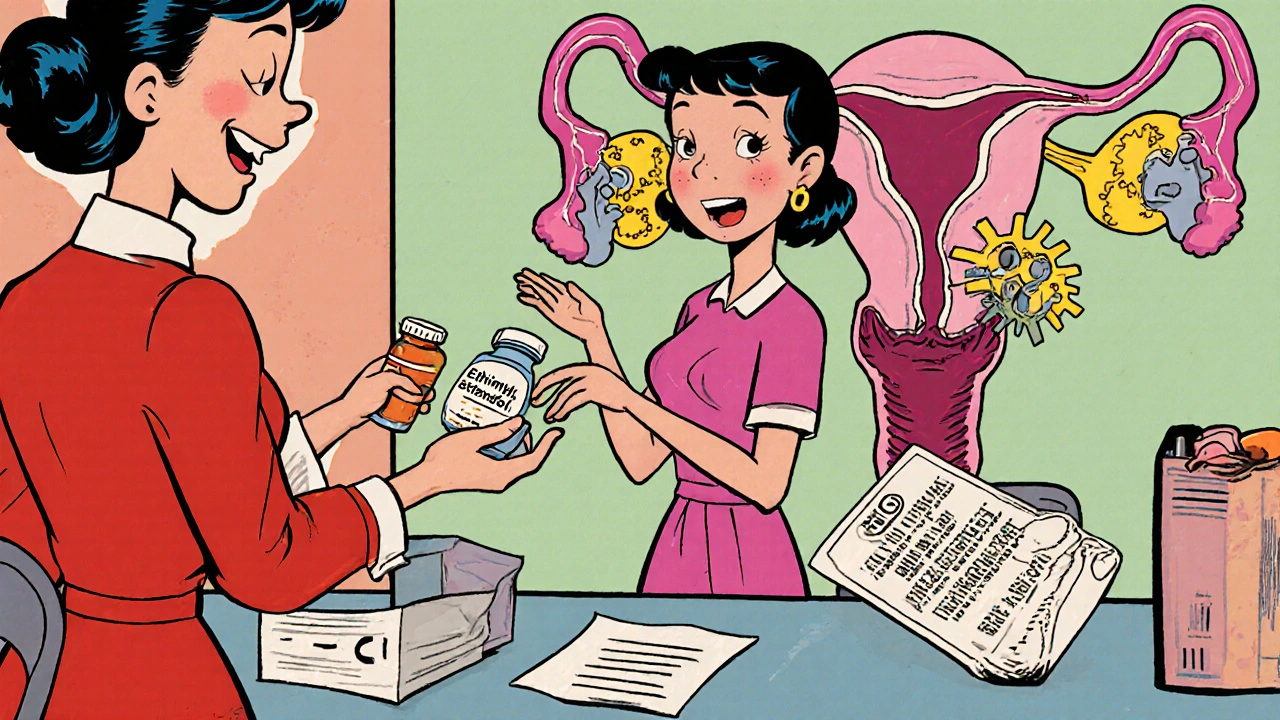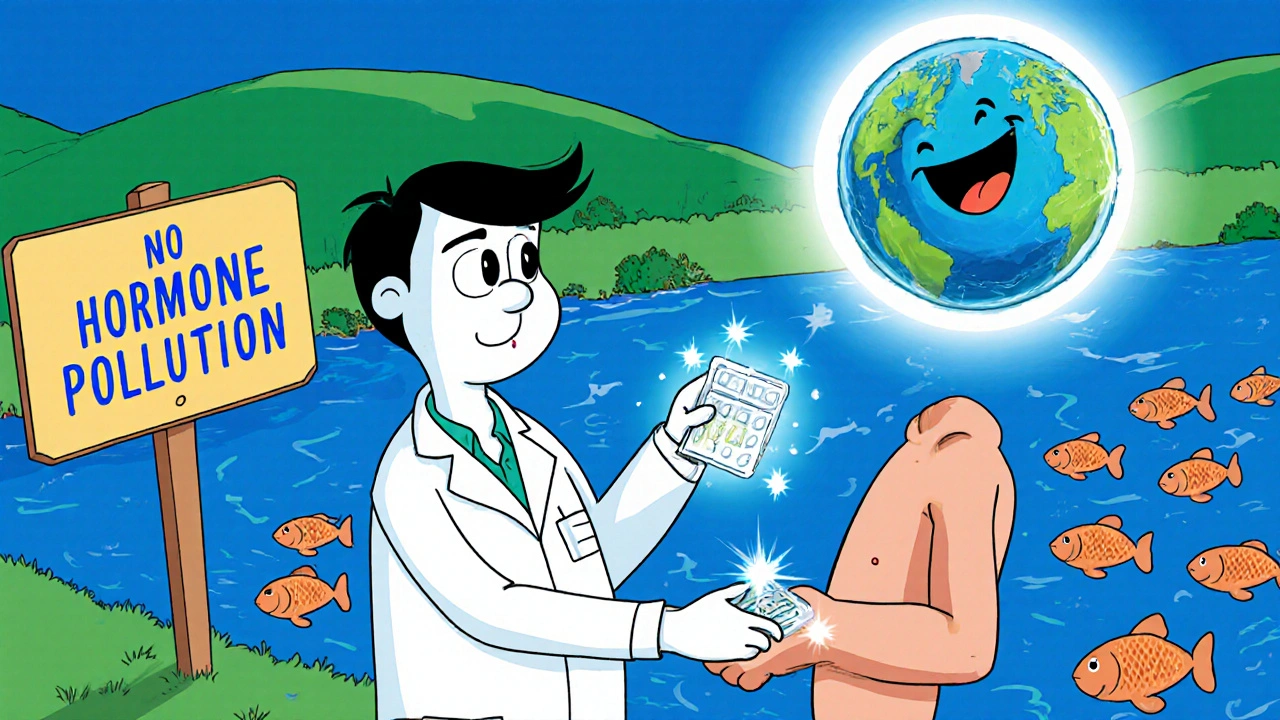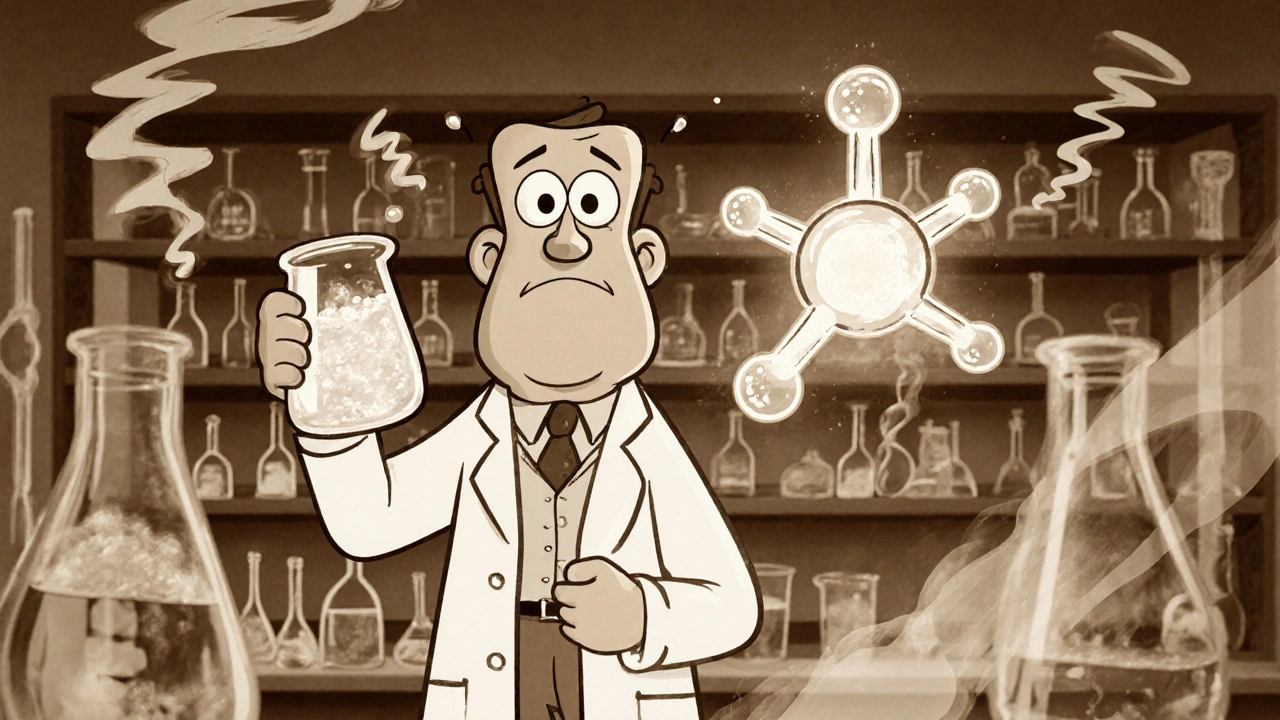Ethinylestradiol Bioavailability Calculator
Ethinylestradiol Bioavailability Calculator
Ethinylestradiol has approximately 50% oral bioavailability. This means about half of the dose you take orally reaches systemic circulation unchanged.
Why this matters: The 50% bioavailability is why ethinylestradiol (20-35 µg per pill) provides effective contraception while minimizing side effects compared to earlier high-dose formulations. This property made it the ideal estrogen for the birth control pill.
When you hear the name Ethinylestradiol, you probably picture a tiny pill that prevents pregnancy. But behind that simple tablet lies a story that stretches back over 80 years, involving chemistry breakthroughs, legal battles, and shifts in how society thinks about women’s health. Below we walk through the key milestones that turned a lab curiosity into the backbone of modern birth control and hormone therapy.
Early Days: From Natural Estrogen to Synthetic Analogs
In the 1920s and 1930s, scientists finally isolated estradiol, the primary estrogen produced by the ovaries. Estradiol was powerful, but it vanished from the bloodstream within minutes-far too short for any practical medical use. Researchers quickly asked: could we make a version that sticks around longer?
Enter ethinylestradiol, first synthesized in 1938 by chemist Hans Herloff Inhoffen at Schering AG. By attaching an ethinyl group at the 17‑alpha position, the molecule became resistant to hepatic metabolism, extending its half‑life dramatically. The result was a synthetic estrogen that could be taken orally and still achieve therapeutic blood levels.
First Clinical Uses: Menopause and Hormone Replacement
During the 1940s, ethynyl‑modified estrogens were tested for menopausal symptom relief. The drug showed promising effects on hot flashes and vaginal atrophy, thanks to its sustained estrogenic activity. However, early formulations contained high doses that sometimes caused side effects like nausea and fluid retention.
It wasn’t until the 1950s that pharmaceutical companies refined dosing. Syntex, a Mexican‑American firm, introduced a low‑dose version marketed as “Estinyl.” Physicians began prescribing it not just for menopause but also for menstrual irregularities, paving the way for the next big leap: contraception.
Birth Control Breakthrough: The Pill’s Core Ingredient
By the early 1960s, a new class of “combined oral contraceptives” (COCs) emerged, pairing a synthetic estrogen with a progestin. Ethinylestradiol quickly became the estrogen of choice because its potency allowed manufacturers to keep the dosage low-typically 20-35µg per pill-minimizing estrogen‑related side effects.
The first FDA‑approved birth‑control pill, Enovid, launched in 1960, initially contained mestranol (a prodrug of ethynylestradiol). In 1965, the FDA approved a reformulation that swapped mestranol for direct ethynylestradiol, recognizing its more predictable pharmacokinetics. This switch is considered a turning point: it gave doctors a reliable way to control ovulation without the erratic hormone spikes seen in earlier attempts.
Pharmacokinetics and the Science Behind the Dose
Why does ethynylestradiol work so well in a 28‑day pill pack? The answer lies in its binding affinity to the estrogen receptor (ER) and its resistance to first‑pass metabolism. After oral ingestion, about 50% of the dose reaches systemic circulation unchanged-a remarkable figure for a steroid hormone.
Once in the bloodstream, ethynylestradiol binds to albumin and, to a lesser extent, sex‑hormone‑binding globulin (SHBG). This dynamic creates a steady‑state concentration that suppresses the luteinizing hormone (LH) surge, preventing the follicular rupture that leads to ovulation. The low dose also reduces the risk of thromboembolic events compared to earlier high‑dose estrogen therapies.

Regulatory Milestones and Global Adoption
After the FDA’s green light, the World Health Organization (WHO) began assessing the pill’s safety for developing nations. By the late 1970s, over 30 countries had incorporated ethynylestradiol‑based COCs into their national family‑planning programs. The drug’s inclusion on the WHO’s List of Essential Medicines cemented its status as a public‑health cornerstone.
Regulatory agencies worldwide have since refined acceptable dose ranges. In the United States, the FDA now caps ethynylestradiol at 35µg per tablet for most combined pills, while some low‑dose European formulations dip to 20µg, reflecting ongoing research into the minimum effective dose.
Beyond Contraception: Other Therapeutic Roles
While birth control remains ethynylestradiol’s flagship use, the hormone has found a foothold in other areas:
- Hormone replacement therapy (HRT): Low‑dose ethynylestradiol combined with a progestin can treat menopausal symptoms in women who cannot tolerate natural estrogens.
- Transgender hormone therapy: Some clinicians prescribe ethynylestradiol to achieve estrogenic effects in male‑to‑female transitions, though it’s less favored than 17β‑estradiol due to cardiovascular risk.
- Acne treatment: Certain oral contraceptives containing ethynylestradiol are FDA‑approved for moderate acne, leveraging estrogen’s ability to reduce sebum production.
Each use reflects a balance between efficacy and safety-lower doses meet therapeutic goals while keeping side‑effects in check.
Controversies and Safety Concerns
The pill’s impact on society is undeniable, yet it hasn’t been free from controversy. Early studies in the 1970s linked high‑dose estrogen pills to increased blood clot risk. This prompted a re‑evaluation of dosing, leading to the low‑dose regimens we see today.
More recent debates focus on the environmental footprint. Ethinylestradiol is excreted unchanged and can be detected in surface waters, raising questions about endocrine disruption in wildlife. Researchers are exploring biodegradable estrogen analogs, but for now, wastewater treatment upgrades remain the main mitigation strategy.
Future Directions: New Formulations and Alternatives
Innovation continues. Scientists are experimenting with transdermal patches that deliver ethynylestradiol directly into the bloodstream, bypassing the liver and potentially reducing clot risk. Another avenue is the development of selective estrogen receptor modulators (SERMs) that mimic the beneficial effects of ethynylestradiol without its drawbacks.
Meanwhile, the rise of “mini‑pills” (progestin‑only) offers an alternative for women who can’t tolerate any estrogen. Still, ethynylestradiol’s proven track record keeps it at the core of most combined contraceptives worldwide.

Quick Reference Table
| Attribute | Ethinylestradiol | Estradiol (natural) | Mestranol (prodrug) |
|---|---|---|---|
| Year first synthesized | 1938 | 1935 | 1938 |
| Oral bioavailability | ≈50% | <5% | ≈30% |
| Half‑life (hours) | ≈24 | ≈1‑2 | ≈12 (converted to ethynylestradiol) |
| Typical COC dose (µg) | 20‑35 | Not used in COCs | 150‑300 (as prodrug) |
| Major side‑effects | Clot risk, nausea | Water retention, breast tenderness | Similar to ethynylestradiol after conversion |
Frequently Asked Questions
Frequently Asked Questions
Why is ethynylestradiol preferred over natural estradiol in birth‑control pills?
Ethinylestradiol resists liver breakdown, so a tiny dose stays in the blood long enough to reliably suppress ovulation. Natural estradiol vanishes too quickly for once‑daily dosing.
What dose of ethynylestradiol is considered low‑risk?
Most modern combined pills use 20‑35µg per tablet. Studies show this range balances contraceptive effectiveness with the lowest observed clot risk.
Can ethynylestradiol be used for hormone replacement therapy?
Yes, low‑dose ethynylestradiol combined with a progestin is prescribed for menopausal symptoms, especially when women need a convenient oral option.
Is ethynylestradiol harmful to the environment?
Trace amounts show up in waterways because the hormone is excreted unchanged. It can affect fish reproduction, prompting upgrades to wastewater treatment and research into greener analogs.
How does ethynylestradiol differ from mestranol?
Mestranol is a prodrug; once taken, the liver converts it into ethynylestradiol. Direct ethynylestradiol avoids that conversion step, giving more predictable blood levels.
Wrapping Up the Journey
From a daring 1938 lab synthesis to a staple in dozens of birth‑control brands, ethynylestradiol’s path mirrors the broader evolution of women’s health care. Its chemistry solved a practical problem-how to make estrogen work orally-while its social impact reshaped families worldwide. As researchers keep tweaking doses, exploring new delivery methods, and addressing ecological concerns, one thing stays clear: ethynylestradiol remains a cornerstone of modern hormone therapy.


Yassin Hammachi
Reading through the timeline of ethinyl‑estradiol really highlights how scientific curiosity can ripple into societal change. It's fascinating to see chemistry, medicine, and women's rights intersecting across decades. The early work on estradiol set the stage, but the clever tweak with the ethinyl group turned a fleeting molecule into a practical oral drug. From the 1960s pill revolution to today's low‑dose formulations, each step reflects both progress and the need for continual safety monitoring. It's a reminder that breakthroughs often come from iterative improvements rather than single eureka moments.
Michael Wall
It's unacceptable that a hormone designed for health was ever marketed without full transparency about its risks.
Christopher Xompero
The saga of ethinyl‑estradiol reads like an over‑the‑top drama that Hollywood could barely script.
You start with the 1930s chemist, Hans Herloff Inhoffen, who seemingly played God by splicing an ethinyl group onto estradiol.
That tiny chemical tweak turned a hormone that vanished in minutes into a molecule that could survive the liver's relentless grind.
Fast forward to the 1950s, and the pharma giants were already rolling out low‑dose “Estinyl” tablets, promising menopause relief while silently banking billions.
Then the 1960s arrived, and suddenly millions of women were popping pills that prevented pregnancy, a cultural shift that made headlines and sparked protests.
The FDA approved Enovid, originally with mestranol, but by 1965 they swapped in direct ethinyl‑estradiol because it gave doctors a more predictable hormone curve.
What many ignored was the creeping evidence that high‑dose estrogen could thicken blood and increase clot risk, a danger that only hit the headlines after tragic deaths.
Researchers scrambled to lower the dose, and by the 1980s, 20‑35 µg pills became the norm, ostensibly balancing efficacy with safety.
Yet the environmental fallout sneaked in quietly-traces of ethinyl‑estradiol now linger in rivers, messing with fish reproduction across continents.
Scientists are now hunting for biodegradable analogs, but the world still relies on a hormone that never truly disappears.
In transgender hormone therapy, some clinicians still reach for ethinyl‑estradiol despite its cardiovascular red flags, preferring more natural forms of estrogen when possible.
The pill's cultural impact is undeniable; it gave women control over fertility, which sparked debates about autonomy, morality, and the role of the state in private lives.
But let’s not forget the corporate lobby that pushed the pill into schools and workplaces, often downplaying side‑effects to meet market demand.
Every new formulation-be it transdermal patches or selective estrogen receptor modulators-carries the ghost of that original 1938 discovery.
So, while we celebrate ethinyl‑estradiol's contributions, we must stay vigilant about its lingering health and ecological shadows.
Irene Harty
One cannot overlook the possibility that pharmaceutical conglomerates deliberately obscured early adverse data regarding thromboembolic events associated with high‑dose ethinyl‑estradiol. The chronology of regulatory approvals suggests a pattern of influence that extends beyond mere scientific discourse, hinting at a concerted effort to prioritize profit over public welfare. Such considerations compel a reevaluation of historical narratives that celebrate the pill without scrutinizing the hidden costs imposed on countless women.
Jason Lancer
Honestly, these long‑winded histories get the facts right but feel like a textbook lecture. The drug’s benefits are clear, yet the side‑effects and environmental impact get a quick gloss‑over. I wish there was a more balanced take that doesn’t just praise the pill without pointing out the baggage it carries.
Brooks Gregoria
Calling ethinyl‑estradiol the “backbone” of modern contraception is an overstatement; many newer formulations are moving away from it due to safety concerns. The industry loves to hype legacy drugs while ignoring innovative alternatives that offer comparable efficacy with fewer risks.
Sumit(Sirin) Vadaviya
Great overview! It's impressive how a single molecular modification reshaped reproductive health worldwide 🌍. The environmental angle is especially eye‑opening, and it underscores the need for greener pharmaceutical practices.
lindsey tran
Wow, such an awsome read! Your timeline shows just how far we’ve come, and it gives me hope that future breakthroughs will keep improving women's health. Keep up the amazing work!!!
Krishna Sirdar
Thanks for sharing this detailed history. It helps people understand why we still see ethinyl‑estradiol in many meds and why safety is always a top priority.
becca skyy
I get what you mean about the dense presentation; sometimes a concise summary works better for quick readers.
Theo Roussel
The pharmacokinetic profile of ethinyl‑estradiol, characterized by its high oral bioavailability (~50%) and strong affinity for estrogen receptors, underpins its utility in combined oral contraceptives. Its resistance to first‑pass hepatic metabolism, mediated by the 17‑α‑ethynyl group, facilitates a steady plasma concentration that effectively suppresses the LH surge, thereby inhibiting ovulation.
Erick Masese
Indeed, distilling complex pharmacological narratives into digestible formats can enhance comprehension without sacrificing rigor. By highlighting key mechanistic pathways, we empower clinicians and patients alike to make informed decisions regarding hormone therapy.
Matthew Charlton
Great job compiling all these milestones! It's clear that each breakthrough built upon the last, and your summary makes the evolution of ethinyl‑estradiol accessible to everyone.
Pamela may
Look, the story of ethinyl‑estradiol isn’t just a neat chronology of scientific breakthroughs; it’s also a saga of corporate maneuvering, regulatory back‑flipping, and public health trade‑offs that have left a lasting imprint on both medicine and the environment. While the pill gave unprecedented reproductive autonomy, it simultaneously opened a Pandora’s box of side‑effects, from increased clotting risk to subtle hormonal disruptions that still puzzle researchers today. The fact that trace amounts of this synthetic estrogen are still being detected in rivers and lakes worldwide speaks volumes about the unintended ecological footprints we often ignore in our rush for convenience. Moreover, the pivot toward ultra‑low‑dose formulations, though well‑intentioned, sometimes masks the underlying issue that we’re still relying on a molecule synthesized over eight decades ago, rather than seeking truly novel, safer alternatives. So, as we celebrate the milestones, let’s also keep a critical eye on the gaps and the lingering shadows that this hormone casts across health and the planet.
tierra hopkins
Totally agree-making the science understandable is key, but we also need to keep an eye on the broader impacts you mentioned.
Ryan Walsh
Nice rundown! It’s helpful to see how regulatory limits have evolved and why low‑dose pills are now standard.
Kiersten Denton
I appreciate the balanced tone; it’s good to get both the benefits and the concerns laid out.
Karl Norton
While the overview is thorough, it glosses over how many women were coerced into using the pill without fully understanding the long‑term health implications, a point that deserves more emphasis.